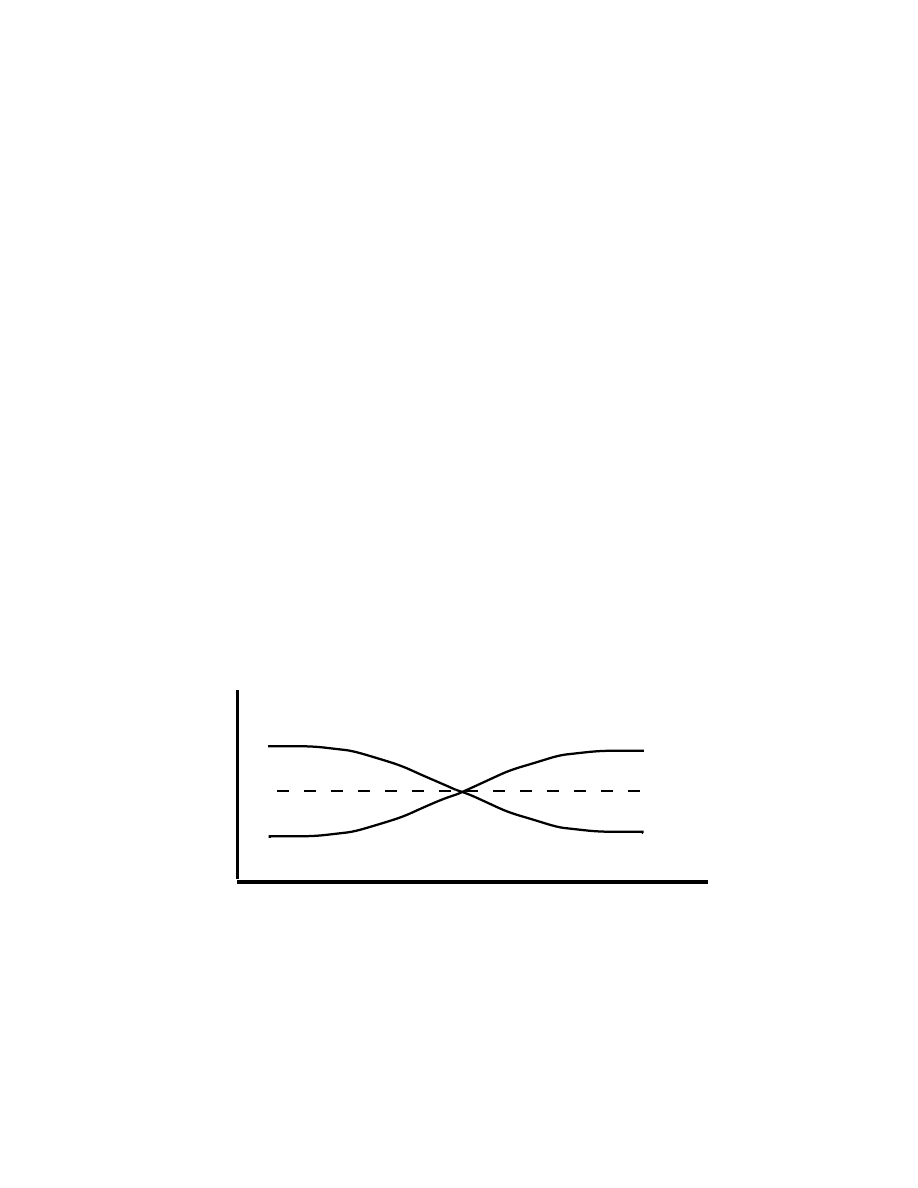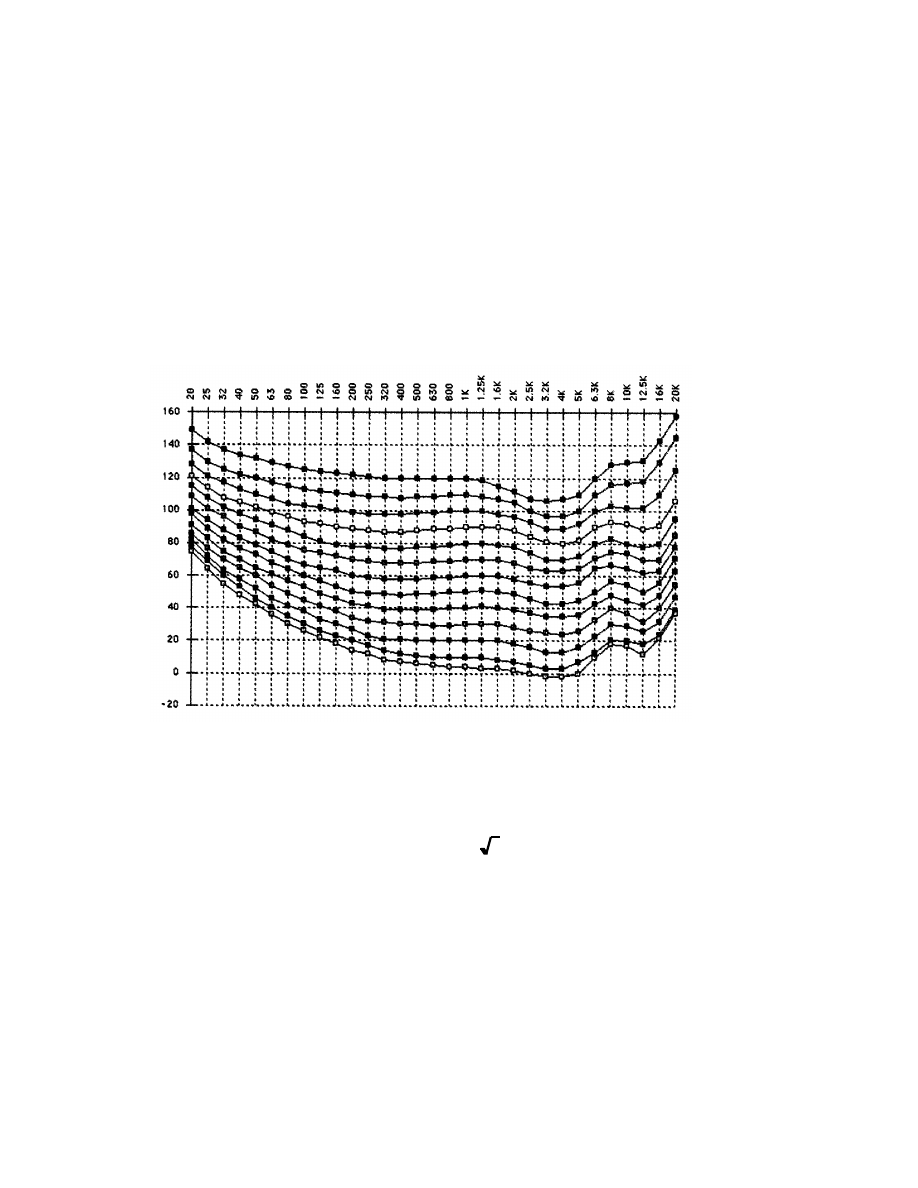ВУЗ: Казахская Национальная Академия Искусств им. Т. Жургенова
Категория: Учебное пособие
Дисциплина: Не указана
Добавлен: 03.02.2019
Просмотров: 12344
Скачиваний: 6

E
EFM: Eight-to-Fourteen Modulation. The data encoding scheme used in CDs in order to op-
timize the process of reading off the disk. Groups of eight data bits are regrouped into
fourteen-bit blocks by EFM modulator during cutting of the CD master, permitting about 25%
greater data density to be laser-inscribed on the disc and allowing easier error recognition.
An EFM demodulator in the CD player decodes the data.
EIAJ: Electronic Industries Association of Japan.
EIDE: See IDE.
eigentone: See standing wave.
EK neg: Eastman Kodak negative. Film laboratory colloquialism for “original camera nega-
tive.” Used in film production to describe a release print made from the original negative,
whether or not any of the film involved was actually made by Kodak, Inc. Also called an
OCN, probably for Original Color Negative.
electret: If two metal plates have molten wax poured between them and a high DC voltage
is sent across the two plates, this assembly yields a permanent electric field, in the same way
that a magnet produces a permanent magnetic field. It is hypothesized that the polar mole-
cules in the wax align, producing the electric field. An assembly of this type is used to pro-
vide a polarization voltage for small condenser microphones so that they do not require phan-
tom power at 48V, but operate instead at a small pre-amplified voltage of 5V-12V. Micro-
phones constructed in this way are called electret microphones.
electroacoustic: The name for interactions between electrical and acoustic phenomena. The
science of electroacoustics deals with the application of electrical principles and apparatus to
acoustical phenomena. Transducers, such as microphones and loudspeakers, are electroa-
coustic devices.
electroacoustic transducer: A device which converts sound waves to electrical signals.
Transducers such as microphones, loudspeakers, and phonograph cartridges are electroacousti-
cal devices. The primary problem with electroacoustic transducers is that they do not ex-
hibit a linear frequency response except for a relatively small range of signal frequency and
amplitude. See DI.
electromagnetic (EM): The name for interactions between electrical and magnetic phenom-
ena. The science of electromagnetics deals with the application of electrical principles and
apparatus to magnetic phenomena. Transformers, antennæ, and phonograph cartridges are
electromagnetic devices. Longer explanation: There are four known forces operating in the
universe: strong and weak nuclear forces, gravity, and electromagnetism, the latter two be-
ing the two manifestations of electromagnetic force. These are mutually affective, i.e., a
magnetic field can influence an electric field and vice versa as an electromagnetic wave con-
sists of both an electric field and a related perpendicular magnetic field. The electromagnetic
spectrum consists of (in order of increasing frequency) radio waves, microwaves, infrared
light (heat), visible light, UV light, X-rays and gamma rays. All electromagnetic waves
propagate at the same speed, the speed of light.
electromagnetic compatibility (EMC): Audio equipment that is designed to be immune to
EMI is said to be electromagnetically compatible. Shielding is one EMI technique, as is line-
filtering, etc.

E
electromagnetic pick-up: See piezo pick-up, DI.
electronic feedback: See feedback.
electrostatic loudspeaker: A dipole speaker with a transducer that uses the audio signal to
vary the strength of an electric field which, in turn, induces vibration in a metallic or metal-
ized membrane. In principle, it is the reverse of an electrostatic microphone, and very different
from the more common electromagnetic voice coil arrangement. Used for consumer equip-
ment as the power output is low. Electrostatic speakers are usually quite large, such as 6’
high by 2’ or 3’ wide. They are always direct radiators, and they must be large to attain rea-
sonable efficiency at low frequencies. The radiation pattern of an electrostatic speaker in a
free-field is similar to that of a figure-eight microphone. Because of their large size, electro-
static loudspeakers tend to become very directional in the high-frequency range. They are
also characterized by a low impedance, and this is problematic for some amplifiers. See also
planar loudspeaker.
electrostatic microphone: A class of microphone, of which condenser and electret are types,
in which air pressure changes cause changes in the capacitance of a condenser. The capacitor
is normally biased by a voltage which is supplied from batteries or via phantom power from
the signal cable. The electret is an exception, as this requires such a small biasing voltage
that it is possible to charge it permanently at the time of manufacture; Sennheiser mics use a
proprietary biasing scheme which utilizes RF instead of a DC voltage.
electrostatic noise: A field of random electrical charges that can affect an audio line.
Electrostatic noise can be generated by neon or fluorescent lighting, electrical motors, and
other broad-spectrum emissions sources. Electrostatic noise is the electrical field which is
generated by EMI.
elliptical equalizer: A special equalizer which causes the two channels of a stereo signal to
be more nearly in phase at low frequencies, making the signal easier to cut into a record (an
LP stylus has an elliptical cross-section).
elliptical filter: A multiple-element, lowpass or bandpass filter which has the steepest possible
rolloff slope and a small amount of ripple in the passband, with one or more notch filters added
to it. Elliptical filters are used as anti-aliasing filters in digital audio devices.
EMI: Electromagnetic Interference. Stray electromagnetic fields generated from any current-
carrying conductor such as nearby motors, switching controllers, high-power contactors, etc.
which cause a brief, intense pulse that often couples into low-level signal circuits causing
noise. This interference can enter either directly into the signal path, or indirectly via the
power or ground connection. High-power RF transmitters can cause similar effects, called
RFI. See induction.
emphasis: See resonance.
encoding: (1) The process of converting the already sampled, numerical voltage of the ana-
log input into binary numbers and assembling these with any location and error-related data
generated elsewhere into complete digital words, usually of 16 bits. See analog-to-digital con-
verter. (2) The application of any type of processing to a signal before recording which will
later be removed by complementary processing during playback. Most NR systems are good
examples of the encoding/decoding process. See stretched.

E
end-addressed: A microphone that is aimed at the sound source, as opposed to side-
addressed, which is aimed with the side of the mic at the sound source.
Enhanced CD: A multisession CD format which allows Red Book, Yellow Book and Blue
Book CD data to be stored on one disc. See CD Extra.
envelope: The shape of the amplitude vs. time graph of a musical sound; the shape of a
sound as it changes over time. The shape of a synthesizer’s envelope is controlled by a set of
rate (or time) and level parameters. The envelope is a control signal that can be applied to
various aspects of a synthesizer’s sound, such as pitch, filter rolloff frequency, and overall am-
plitude. Usually, each note has its own envelope(s).
envelope follower: A device used in electronic music synthesis that converts the envelope of
a musical signal into a control voltage. That is, the output voltage will be low when the signal
is soft and high when the signal is loud. The control voltage can then be used to control any
number of parameters in the synthesizer.
envelope generator: A hardware device or software routine that generates a sound envelope.
Also known as a contour generator or transient generator because the envelope is a contour
(shape) that is used to create some of the transient (changing) characteristics of the sound
over time. The purpose of an envelope generator is to give a shape to each note. By itself,
an envelope generator makes no sound. Its output is used as a control source that tells some
other part of the synthesizer what to do. Typical synths have three envelope generators for
each oscillator: one to control pitch, one to control the filter rolloff, and one to control ampli-
tude. See ADSR.
envelope tracking: A function that changes the length of one or more envelope segments de-
pending on which key on the keyboard is being played. Envelope tracking is most often
used to give higher notes shorter envelopes and the lower notes longer envelopes, mimick-
ing the response characteristics of percussion-activated acoustic instruments. Also called
keyboard tracking, key follow, and keyboard rate scaling. See ADSR.
EOX: End Of eXclusive. A System-Common MIDI message used as a flag in a MIDI
datastream to indicate the end of a System-Exclusive message transmission.
EP: Extended Play. A type of 7” phonograph record, usually played at 33
1
3
rpm, allowing
two songs to be cut on each side for a total recording time of up to 7 minutes. Also a 10” or
12” album with between three and seven songs. EPs are intended to sell at less than album
prices, and are a way of establishing new artists without requiring record buyers to pay full
LP prices. (2) Also, Executive Producer.

E
equalizer: An adjustable audio filter inserted in a circuit to divide and adjust its frequency
response, altering or distorting the relative amplitude of certain frequency ranges of an audio
signal. The effects processor used for equalization. Equalizers come in two varieties, graphic
and parametric. A graphic equalizer typically has a number of fixed-frequency bands (5-10 in
consumer equipment, 31 in professional equipment), each wired to its own front-panel
slider. The control is over the amount of cut or boost (in dB) at each band. A parametric
equalizer goes two steps further: the center frequency of each band can be selected by the
user, as can the bandwidth. This affords more precise control over which frequencies will be
affected by the boost or cut in amplitude. Because EQ circuitry with these controls is more
expensive to build, a parametric equalizer will typically provide fewer bands than a graphic
equalizer. A semi-parametric equalizer, sometimes found in multieffects devices, provides
control over the center frequency of each band, but not over the bandwidth. See also active
equalizer, passive equalizer, shelving equalizer, Q.
equalization (EQ): An effect that allows the frequency-selective manipulation of a signal’s
amplitude. The simplest equalizers are shelving types, offering the ability to cut or boost gain
above or below a given frequency. Equalization doesn’t only change the level of specific
parts of the audio spectrum, it also changes the phase of the affected frequencies relative to
those that aren’t being EQ’d, i.e., EQ affects both the frequency response and phase relation-
ships of the signal. See composite equalization, pre-emphasis, room equalization.
equalization curve: In tape recording and playback, a standardized equalization effect ap-
plied to an audio signal. Pre-emphasis and the complementary de-emphasis curve is applied to
the recorded and reproduced signal, respectively. Pre- and post- equalization curves are dif-
ferent for each standard tape speed, and standards are given by the various organizations
such as NAB, CCIR, and IES for their respective countries. Also described as a pre-emphasis
curve and de-emphasis or post-emphasis curve. See also RIAA curve.
Pre-Emphasis
A
B
C
20 Hz
20 kHz
Pre-Emphasis and Post-Emphasis Curves
Post-Emphasis
Playback
Amplitude

E
equal loudness curves: Also known as Fletcher-Munson curves or phon lines. Equal loudness
curves are the inverse of frequency response curves and reflect the phenomenon that humans
do not hear all frequencies as having equal loudness. In other words, human hearing is not
liner in frequency. This is particularly problematic in recording as a mixed master will be
perceived differently depending on the playback level. Specifically, there is a marked drop-
off in aural sensitivity at low frequencies. At the opposite extreme, humans have high sen-
sitivity to sounds in the 1kHz-8kHz range, with sound again dropping away above 12kHz.
Also called equal loudness contours.
In the graph below, note that at 60dB SPL, a 1kHz tone is perceived as of equal loudness as a
20Hz tone at over 100dB SPL. At low levels, these differences are accentuated: the same
1kHz tone at 10dB SPL requires 80dB SPL at 20Hz.
Robinson-Dadson Equal Loudness Curves
20 Hz - 20 kHz
Right-Hand Legend Reference 1kHz
10
110
120
100
90
80
70
60
50
40
30
20
MAF
equal-tempered: A system of tuning in which the diatonic comma is divided equally between
the twelve half-steps of the octave. All the half-steps are equal in size and are exactly one-
twelfth of an octave, spanning a frequency ratio of 2
12
, or about 6%, or 1:1.059. In equal
temperament, all the intervals are the same regardless of the key in which one is playing, and
none except the octave is perfectly tuned. This makes it very easy to modulate from one key
to another, although the keys lose their individuality because they all have equal intervals.
The result is that the fourth and fifths are within 0.001% of just intervals, however the thirds
are about 0.01% away from pure thirds which produce audible beats, the thirds in all keys
being equally bad. See temperament, syntonic comma, diatonic comma.
equivalent input noise (EIN): EIN is becomming a common method for specifying noise in
audio equipment. This is a derived figure equal to the noise measued at some gain setting,
minus the gain. For example, if a microphone preamplifier puts out -85dBV noise when set
for 40dB of gain, the EIN is -125dBV. Note that, while -125dBV seems better than -85dB,
both figures represent the same amount of noise.